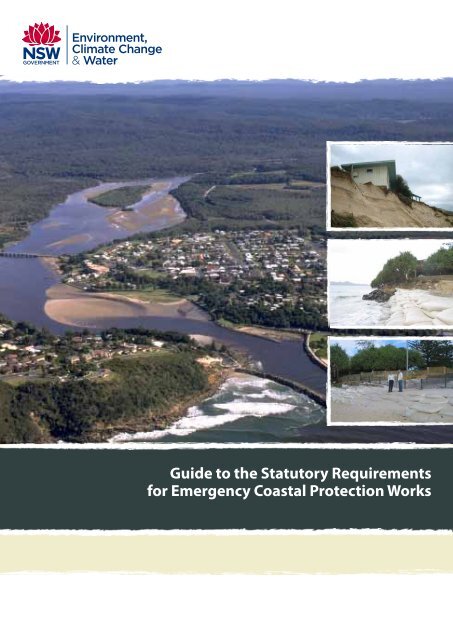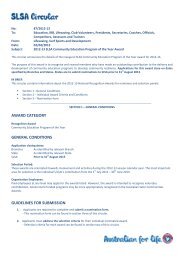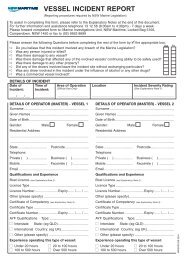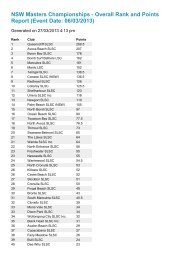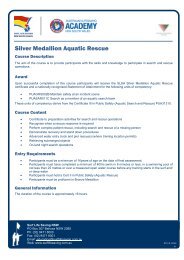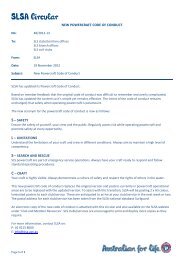Guide to the statutory requirements for emergency coastal protection ...
Guide to the statutory requirements for emergency coastal protection ...
Guide to the statutory requirements for emergency coastal protection ...
You also want an ePaper? Increase the reach of your titles
YUMPU automatically turns print PDFs into web optimized ePapers that Google loves.
<strong>Guide</strong> <strong>to</strong> <strong>the</strong> Statu<strong>to</strong>ry Requirements<br />
<strong>for</strong> Emergency Coastal Protection Works
Cover pho<strong>to</strong>graphs: main pho<strong>to</strong> – Evans Head entrance, DECCW; o<strong>the</strong>r pho<strong>to</strong>s <strong>to</strong>p <strong>to</strong> bot<strong>to</strong>m –<br />
erosion at Old Bar, R. Slatter, DECCW; sandbags at Byron Bay, M. Sharpin, DECCW; sandbags at Byron<br />
Bay, M. Sharpin, DECCW<br />
© Copyright State of NSW and Department of Environment, Climate Change and Water NSW 2011<br />
The Department of Environment, Climate Change and Water and <strong>the</strong> State of NSW are pleased<br />
<strong>to</strong> allow this material <strong>to</strong> be reproduced <strong>for</strong> educational or non-commercial purposes in whole<br />
or in part, provided <strong>the</strong> meaning is unchanged and its source, publisher and authorship are<br />
acknowledged.<br />
Disclaimer: Although every reasonable ef<strong>for</strong>t has been made <strong>to</strong> ensure that this document is<br />
correct at <strong>the</strong> time of publication, <strong>the</strong> State of NSW, its agencies and employees, disclaim any and all<br />
liability <strong>to</strong> any person in respect of anything or <strong>the</strong> consequences of anything done or omitted <strong>to</strong><br />
be done in reliance upon <strong>the</strong> whole or any part of this document. No representation is made about<br />
<strong>the</strong> accuracy, completeness or suitability of <strong>the</strong> source material included in this document <strong>for</strong> any<br />
particular purpose. Readers should consult <strong>the</strong> source material referred <strong>to</strong> and, where necessary,<br />
seek appropriate advice about <strong>the</strong> suitability of this document <strong>for</strong> <strong>the</strong>ir needs.<br />
Published by:<br />
Department of Environment, Climate Change and Water NSW<br />
59–61 Goulburn Street<br />
PO Box A290<br />
Sydney South 1232<br />
Report pollution and environmental incidents<br />
Environment Line: 131 555 (NSW only) or info@environment.nsw.gov.au<br />
See also www.environment.nsw.gov.au<br />
Phone: (02) 9995 5000 (switchboard)<br />
Phone: 131 555 (environment in<strong>for</strong>mation and publications requests)<br />
Phone: 1300 361 967 (national parks , climate change and energy efficiency in<strong>for</strong>mation<br />
and publications requests)<br />
Fax: (02) 9995 5999<br />
TTY: (02) 9211 4723<br />
Email: info@environment.nsw.gov.au<br />
Website: www.environment.nsw.gov.au<br />
ISBN 978-1-74293-049-7<br />
DECCW 2010/1017<br />
March 2011
Contents<br />
1 Introduction ...................................................................................................................1<br />
2 Emergency <strong>coastal</strong> <strong>protection</strong> works .........................................................................3<br />
3 Applying <strong>for</strong> a certificate <strong>to</strong> install works...................................................................5<br />
4 Circumstances under which works may be installed................................................6<br />
5 Material <strong>requirements</strong>...................................................................................................9<br />
6 Construction, maintenance and removal <strong>requirements</strong>..........................................10<br />
7 Safety <strong>requirements</strong>....................................................................................................12<br />
8 Using public land ........................................................................................................13<br />
9 Landowner preparations ............................................................................................14<br />
10 O<strong>the</strong>r legal <strong>requirements</strong>............................................................................................15<br />
11 O<strong>the</strong>r <strong>coastal</strong> <strong>protection</strong> works by landowners.......................................................16<br />
Glossary................................................................................................................................17<br />
Appendix – Checklist <strong>for</strong> landowners ................................................................................18
1 Introduction<br />
This guide will help beachfront landowners and people acting on <strong>the</strong>ir behalf <strong>to</strong> better<br />
understand <strong>the</strong> statu<strong>to</strong>ry <strong>requirements</strong> <strong>for</strong> installing, maintaining and removing <strong>emergency</strong><br />
<strong>coastal</strong> <strong>protection</strong> works. Emergency <strong>coastal</strong> <strong>protection</strong> works are sand or sandbags that<br />
meet <strong>the</strong> <strong>requirements</strong> under <strong>the</strong> Coastal Protection Act 1979 (see section 2 <strong>for</strong> more<br />
details).<br />
Emergency <strong>coastal</strong> <strong>protection</strong> works allow landowners <strong>to</strong> reduce <strong>the</strong> impacts or likely<br />
impacts of <strong>coastal</strong> erosion on a building or buildings that is or are lawfully used <strong>for</strong><br />
residential, commercial or community purposes. Landowners have full responsibility and<br />
liability <strong>for</strong> constructing, installing and maintaining <strong>the</strong>se works.<br />
Landowners can construct and install <strong>the</strong>se works <strong>for</strong> a particular parcel of land under<br />
specified conditions <strong>for</strong> up <strong>to</strong> twelve months, or <strong>for</strong> longer if a development application is<br />
lodged <strong>for</strong> longer-term <strong>coastal</strong> <strong>protection</strong> works. During this period, landowners should<br />
develop a longer-term approach <strong>for</strong> managing erosion risks <strong>to</strong> <strong>the</strong>ir properties.<br />
Emergency <strong>coastal</strong> <strong>protection</strong> works can only be installed at specified locations along <strong>the</strong><br />
NSW coastline where residential dwellings or commercial buildings at risk from erosion have<br />
been identified and <strong>the</strong>re is no public road between <strong>the</strong> buildings and <strong>the</strong> beach.<br />
Importantly, <strong>the</strong>se works are likely <strong>to</strong> provide <strong>protection</strong> from wave action during relatively<br />
small s<strong>to</strong>rms or swells which may also coincide with king tides. They may also provide a<br />
nominal or limited degree of <strong>protection</strong> from erosion during medium <strong>to</strong> large s<strong>to</strong>rms;<br />
however, <strong>the</strong>y are also likely <strong>to</strong> be damaged during such s<strong>to</strong>rms. As a result, <strong>the</strong>se works are<br />
not a long-term management option <strong>for</strong> <strong>coastal</strong> hazard threats. They must not result in<br />
adverse off-site environmental or erosion impacts.<br />
Under specified circumstances, <strong>the</strong> legislation allows landowners <strong>to</strong>:<br />
<br />
install, maintain and remove <strong>emergency</strong> works in accordance with <strong>requirements</strong> under<br />
<strong>the</strong> Coastal Protection Act 1979 and avoid <strong>the</strong> need <strong>for</strong> any o<strong>the</strong>r approvals under o<strong>the</strong>r<br />
legislation – <strong>the</strong>se allowable <strong>emergency</strong> works are relatively small-scale, must not result<br />
in off-site erosion impacts and can be readily removed<br />
apply <strong>to</strong> construct o<strong>the</strong>r types of <strong>coastal</strong> <strong>protection</strong> works of a larger scale than<br />
<strong>emergency</strong> <strong>coastal</strong> <strong>protection</strong> works and which include long-term <strong>protection</strong> works or<br />
alternate temporary or short-term <strong>protection</strong> works. These works will need approvals<br />
under various Acts, including <strong>the</strong> Environmental Planning and Assessment Act 1979. The<br />
landowners will need <strong>to</strong> demonstrate that <strong>the</strong>y (and <strong>the</strong>ir successors in title) commit <strong>to</strong><br />
maintaining <strong>the</strong> works and managing any off-site erosion impacts.<br />
This guide summarises <strong>the</strong> legal <strong>requirements</strong> that apply <strong>to</strong> <strong>emergency</strong> <strong>coastal</strong> <strong>protection</strong><br />
works under <strong>the</strong> Coastal Protection Act 1979, <strong>the</strong> Coastal Protection Regulation 2011 and<br />
<strong>the</strong> Code of Practice under <strong>the</strong> Coastal Protection Act 1979 relating <strong>to</strong> <strong>the</strong> placement of<br />
material as <strong>emergency</strong> <strong>coastal</strong> <strong>protection</strong> works.<br />
For detailed in<strong>for</strong>mation on <strong>the</strong> statu<strong>to</strong>ry <strong>requirements</strong> relating <strong>to</strong> <strong>emergency</strong> <strong>coastal</strong><br />
<strong>protection</strong> works, refer <strong>to</strong>:<br />
<br />
<br />
<br />
<strong>the</strong> Coastal Protection Act 1979 – available at www.legislation.nsw.gov.au<br />
<strong>the</strong> Coastal Protection Regulation 2011 – available at www.legislation.nsw.gov.au<br />
<strong>the</strong> Code of Practice under <strong>the</strong> Coastal Protection Act 1979 (DECCW 2011) – available<br />
at www.environment.nsw.gov.au/coasts/<strong>coastal</strong>mgtdocs.htm – it is a requirement under<br />
<strong>the</strong> Coastal Protection Regulation 2011 <strong>to</strong> follow this Code<br />
<strong>Guide</strong> <strong>to</strong> <strong>the</strong> statu<strong>to</strong>ry <strong>requirements</strong> <strong>for</strong> <strong>emergency</strong> <strong>coastal</strong> <strong>protection</strong> works 1
any <strong>coastal</strong> erosion <strong>emergency</strong> action subplan prepared by <strong>the</strong> relevant local council –<br />
<strong>the</strong>se plans are normally available on <strong>the</strong> council’s website.<br />
This guide was correct at <strong>the</strong> date of publication; however, <strong>the</strong> statu<strong>to</strong>ry <strong>requirements</strong> may<br />
have changed subsequently and <strong>the</strong> new <strong>requirements</strong> take precedence over any<br />
in<strong>for</strong>mation in this guide. For in<strong>for</strong>mation on current legislation, see<br />
www.legislation.nsw.gov.au.<br />
The structure of this guide is as follows:<br />
<br />
<br />
<br />
<br />
<br />
<br />
<br />
<br />
<br />
<br />
section 2 defines <strong>emergency</strong> <strong>coastal</strong> <strong>protection</strong> works<br />
section 3 provides in<strong>for</strong>mation on how <strong>to</strong> obtain a certificate <strong>to</strong> install <strong>emergency</strong> works<br />
section 4 describes <strong>the</strong> circumstances under which works may be installed<br />
section 5 describes materials allowable <strong>for</strong> use in <strong>emergency</strong> works<br />
section 6 outlines <strong>the</strong> minimum construction <strong>requirements</strong> that apply <strong>to</strong> <strong>emergency</strong> works<br />
section 7 contains guidance on safety <strong>requirements</strong> during <strong>the</strong> placing, maintaining and<br />
removal of <strong>emergency</strong> works<br />
section 8 outlines <strong>the</strong> allowable use of public land when installing <strong>the</strong>se works<br />
section 9 advises landowners on preparing <strong>to</strong> install <strong>emergency</strong> works on ways in which<br />
<strong>to</strong> save time and money<br />
section 10 summarises o<strong>the</strong>r legal <strong>requirements</strong> that relate <strong>to</strong> installing <strong>the</strong> works<br />
section 11 provides in<strong>for</strong>mation on o<strong>the</strong>r options <strong>for</strong> landowner-funded <strong>protection</strong> works.<br />
A checklist <strong>to</strong> help landowners understand <strong>the</strong> <strong>requirements</strong> and procedures relating <strong>to</strong><br />
<strong>emergency</strong> <strong>coastal</strong> <strong>protection</strong> works is provided in <strong>the</strong> appendix.<br />
2 <strong>Guide</strong> <strong>to</strong> <strong>the</strong> statu<strong>to</strong>ry <strong>requirements</strong> <strong>for</strong> <strong>emergency</strong> <strong>coastal</strong> <strong>protection</strong> works
2 Emergency <strong>coastal</strong> <strong>protection</strong> works<br />
Emergency <strong>coastal</strong> <strong>protection</strong> works are defined as sand, or fabric bags filled with sand,<br />
placed on a beach or a sand dune adjacent <strong>to</strong> a beach under specific conditions at<br />
authorised locations. They are placed <strong>for</strong> <strong>the</strong> purpose of reducing <strong>the</strong> impact or likely impacts<br />
of <strong>coastal</strong> or beach erosion where this threatens a lawfully erected building which is being<br />
used <strong>for</strong> residential, commercial or community purposes. No o<strong>the</strong>r material can be placed as<br />
<strong>emergency</strong> <strong>coastal</strong> <strong>protection</strong> works.<br />
These works can normally be placed <strong>for</strong> a period of 12 months. However, if <strong>the</strong> landowner<br />
lodges a development application <strong>for</strong> <strong>coastal</strong> <strong>protection</strong> works within this 12 month period,<br />
<strong>the</strong> works can remain until <strong>the</strong> development application is determined. If <strong>the</strong> application is<br />
refused, <strong>the</strong> works need <strong>to</strong> be removed within 21 days. If <strong>the</strong> application is granted, <strong>the</strong><br />
works can remain <strong>for</strong> any fur<strong>the</strong>r period specified in <strong>the</strong> development consent. Landowners<br />
can repair damaged works at any time during this period.<br />
The Coastal Protection Act 1979 specifically excludes placement of rocks, concrete,<br />
construction waste or o<strong>the</strong>r debris. These materials are not permitted as <strong>emergency</strong> works,<br />
as without adequate and site-specific consideration <strong>the</strong>y may exacerbate erosion of beaches<br />
and adjacent land, present a public safety risk and be difficult <strong>to</strong> remove. Significant penalties<br />
apply <strong>for</strong> using unlawful materials and an order may be issued requiring <strong>the</strong>se materials <strong>to</strong> be<br />
removed at <strong>the</strong> expense of <strong>the</strong> person(s) who placed <strong>the</strong>m.<br />
Beachfront landowners wishing <strong>to</strong> install <strong>emergency</strong> works <strong>for</strong> <strong>coastal</strong> <strong>protection</strong> need <strong>to</strong><br />
satisfy a number of conditions or <strong>requirements</strong> as specified in <strong>the</strong> Act, <strong>the</strong> Regulations or <strong>the</strong><br />
Code of Practice, which include:<br />
applying <strong>for</strong> a certificate authorising <strong>the</strong> placing of <strong>the</strong> works<br />
meeting <strong>the</strong> <strong>requirements</strong> <strong>for</strong> circumstances under which <strong>the</strong> works may be placed<br />
using sand or fabric bags filled with sand <strong>for</strong> <strong>the</strong> works<br />
meeting construction <strong>requirements</strong><br />
meeting safety <strong>requirements</strong> when installing, maintaining or removing <strong>the</strong> works.<br />
The landowner is responsible <strong>for</strong> constructing <strong>the</strong> works, and managing <strong>the</strong>ir installation and<br />
maintenance, as well as managing adverse off-site impacts caused by <strong>the</strong> works such as<br />
end scour or increased erosion, and remediating <strong>the</strong> site after <strong>the</strong> works have been removed.<br />
Maintenance includes reinstalling bags that have been dislodged or split, and removing any<br />
bags that have washed on<strong>to</strong> beaches away from <strong>the</strong> works.<br />
As <strong>the</strong> landowner is also responsible <strong>for</strong> ongoing public safety risks associated with <strong>the</strong><br />
works, including <strong>the</strong> construction of <strong>the</strong> works, it is recommended that all landowners seek<br />
appropriate insurance coverage be<strong>for</strong>e initiating any <strong>for</strong>m of <strong>emergency</strong> <strong>coastal</strong> <strong>protection</strong>.<br />
In addition <strong>to</strong> <strong>the</strong> extra rights af<strong>for</strong>ded <strong>to</strong> landowners, this Act also includes powers enabling<br />
certain authorised officers appointed by a public authority (e.g. a local council or Department<br />
of Environment, Climate Change and Water (DECCW) or Land and Property Management<br />
Authority (LPMA)) <strong>to</strong> issue orders that may require <strong>emergency</strong> works <strong>to</strong> be removed or<br />
modified if, in <strong>the</strong> opinion of <strong>the</strong> authorised officer, <strong>the</strong>y:<br />
<br />
<br />
are causing or are likely <strong>to</strong> cause increased erosion of a beach or land adjacent <strong>to</strong> a<br />
beach<br />
are unreasonably limiting or likely <strong>to</strong> unreasonably limit public access <strong>to</strong> a beach or<br />
headland<br />
<strong>Guide</strong> <strong>to</strong> <strong>the</strong> statu<strong>to</strong>ry <strong>requirements</strong> <strong>for</strong> <strong>emergency</strong> <strong>coastal</strong> <strong>protection</strong> works 3
pose or are likely <strong>to</strong> pose a threat <strong>to</strong> public safety<br />
have ceased <strong>to</strong> be <strong>emergency</strong> <strong>coastal</strong> <strong>protection</strong> works.<br />
Under <strong>the</strong> Act, any person who fails <strong>to</strong> comply with an order issued by an authorised officer<br />
is guilty of an offence and may be prosecuted. In such a circumstance, an authorised officer<br />
may carry out <strong>the</strong> actions specified in <strong>the</strong> order (e.g. removal of <strong>the</strong> works) and recover <strong>the</strong><br />
costs from <strong>the</strong> landowner through court action.<br />
4 <strong>Guide</strong> <strong>to</strong> <strong>the</strong> statu<strong>to</strong>ry <strong>requirements</strong> <strong>for</strong> <strong>emergency</strong> <strong>coastal</strong> <strong>protection</strong> works
3 Applying <strong>for</strong> a certificate <strong>to</strong> install works<br />
To install <strong>emergency</strong> <strong>coastal</strong> <strong>protection</strong> works, a landowner or <strong>the</strong>ir authorised representative<br />
must apply <strong>for</strong> a certificate from an <strong>emergency</strong> works authorised officer with <strong>the</strong> local council<br />
or DECCW. The authorised officer is likely <strong>to</strong> inspect <strong>the</strong> site where <strong>the</strong> works are <strong>to</strong> be<br />
installed when considering <strong>the</strong> application <strong>for</strong> <strong>the</strong> certificate. Once a certificate is obtained,<br />
<strong>the</strong> works can be lawfully installed and <strong>the</strong>re is no requirement <strong>to</strong> obtain approvals under<br />
o<strong>the</strong>r legislation which would o<strong>the</strong>rwise apply.<br />
In<strong>for</strong>mation on obtaining a certificate from DECCW is available at<br />
www.environment.nsw.gov.au/coasts/emrgncy<strong>coastal</strong>protworks.htm.<br />
A certificate may be issued unconditionally or subject <strong>to</strong> conditions, and requires <strong>the</strong><br />
payment of a $110 application fee. The certificate is valid <strong>for</strong> two years from <strong>the</strong> date of issue<br />
and <strong>the</strong> landowner may install <strong>the</strong> works at any time during this period. Once placed, <strong>the</strong><br />
works need <strong>to</strong> be removed within 12 months, or longer if a development application is lodged<br />
<strong>for</strong> o<strong>the</strong>r <strong>coastal</strong> <strong>protection</strong> works.<br />
<strong>Guide</strong> <strong>to</strong> <strong>the</strong> statu<strong>to</strong>ry <strong>requirements</strong> <strong>for</strong> <strong>emergency</strong> <strong>coastal</strong> <strong>protection</strong> works 5
4 Circumstances under which works may be installed<br />
Emergency <strong>coastal</strong> <strong>protection</strong> works can only be installed at specific locations along <strong>the</strong><br />
NSW coastline; <strong>the</strong>se locations are listed in table 1 and defined in <strong>the</strong> Code of Practice under<br />
<strong>the</strong> Coastal Protection Act 1979 (DECCW 2011), available at<br />
www.environment.nsw.gov.au/coasts/<strong>coastal</strong>mgtdocs.htm.<br />
Table 1 – Authorised locations <strong>for</strong> <strong>emergency</strong> <strong>coastal</strong> <strong>protection</strong> works<br />
Authorised locations <strong>for</strong> placing works<br />
Basin Beach, Mona Vale<br />
Belongil Beach, Byron Bay<br />
Authorised beach access<br />
Beach access track from corner of Surfview Road and<br />
Basset Street (alternate access – adjacent <strong>to</strong> Mona<br />
Vale Surf Life Saving Club, Seabeach Avenue)<br />
Childe Street; Manfred Street; Don Street<br />
Bilgola Beach, Bilgola From north end of Allen Avenue (alternate access –<br />
Bilgola Avenue at Allen Avenue)<br />
North of outlet from Cakora Lagoon and east<br />
of Ocean Street, Brooms Head<br />
Collaroy Beach, Collaroy<br />
Hargraves Beach, Noraville<br />
Narrabeen Beach, Narrabeen<br />
North Entrance Beach,<br />
The Entrance (North)<br />
Mollymook Beach, Mollymook (between<br />
Donlan Road and Mollymook Creek)<br />
Cabbage Tree Harbour Beach,<br />
Norah Head<br />
Old Bar Beach, Old Bar<br />
Pearl Beach, Pearl Beach<br />
Wamberal Beach, Wamberal<br />
Wooli Beach, Wooli<br />
Track from Ocean Street (south of bridge)<br />
Collaroy Beach carpark (opposite Jenkins Street),<br />
Frazer or Stuart Streets<br />
Elizabeth Drive (north end)<br />
We<strong>the</strong>rill or Mactier Streets, adjacent <strong>to</strong> Narrabeen or<br />
South Narrabeen Surf Life Saving Clubs, Birdwood<br />
Park carpark or Clarke Street<br />
Curtis Parade<br />
Mitchell Parade<br />
Bald Street boat ramp area<br />
Pacific Parade at Rose Street or adjacent <strong>to</strong> <strong>the</strong> Taree<br />
Old Bar Surf Club, Ungala Road<br />
Coral Crescent; Pearl Parade; Gem Road<br />
Adjacent <strong>to</strong> Wamberal Surf Life Saving Club, Dover<br />
Road<br />
Wooli Road (South Terrace)<br />
Works are only permitted <strong>to</strong> be installed <strong>to</strong> reduce <strong>the</strong> impact or likely impact of <strong>coastal</strong><br />
erosion on a building being lawfully used <strong>for</strong> residential, commercial or community purposes.<br />
The works can only be installed when <strong>the</strong> most landward part of an escarpment is within 20<br />
metres of <strong>the</strong> most seaward wall of <strong>the</strong> building (see Figure 1).<br />
6 <strong>Guide</strong> <strong>to</strong> <strong>the</strong> statu<strong>to</strong>ry <strong>requirements</strong> <strong>for</strong> <strong>emergency</strong> <strong>coastal</strong> <strong>protection</strong> works
Figure 1 – Trigger distance <strong>for</strong> installing <strong>emergency</strong> <strong>coastal</strong> <strong>protection</strong> works<br />
A landowner who places <strong>emergency</strong> <strong>coastal</strong> <strong>protection</strong> works where <strong>the</strong> erosion escarpment<br />
is within 20 metres of an eligible building may also may also place <strong>the</strong> works on immediately<br />
adjacent private land (see Figure 2). Note that permission must be obtained from <strong>the</strong><br />
landowner of <strong>the</strong> adjoining property through a lease, easement, right-of-way or o<strong>the</strong>r<br />
mechanism be<strong>for</strong>e works can be placed on this land. The owner of <strong>the</strong> land on which <strong>the</strong><br />
building is at risk from erosion is responsible <strong>for</strong> placing, maintaining and removing <strong>the</strong><br />
<strong>emergency</strong> works on any adjacent private land.<br />
Figure 2 –<br />
Example of <strong>emergency</strong> <strong>coastal</strong> <strong>protection</strong> works on adjacent private land<br />
<strong>Guide</strong> <strong>to</strong> <strong>the</strong> statu<strong>to</strong>ry <strong>requirements</strong> <strong>for</strong> <strong>emergency</strong> <strong>coastal</strong> <strong>protection</strong> works 7
Emergency <strong>coastal</strong> <strong>protection</strong> works cannot be installed if any o<strong>the</strong>r <strong>for</strong>m of <strong>coastal</strong><br />
<strong>protection</strong> (whe<strong>the</strong>r lawfully placed or not) exists. This restriction does not apply if a<br />
professional engineer has provided a written opinion that <strong>the</strong> proposed <strong>emergency</strong> <strong>coastal</strong><br />
<strong>protection</strong> works combined with <strong>the</strong> existing works provide erosion <strong>protection</strong> equivalent <strong>to</strong><br />
<strong>emergency</strong> <strong>coastal</strong> <strong>protection</strong> works alone. For example, <strong>the</strong> engineer may consider that a<br />
small number of sandbags placed on <strong>to</strong>p of a very low rock seawall provides erosion<br />
<strong>protection</strong> equivalent <strong>to</strong> a 1.5 metre high sandbags wall built in accordance with <strong>the</strong><br />
<strong>requirements</strong> described in section 6. The professional engineer’s opinion must be kept by <strong>the</strong><br />
landowner until <strong>the</strong> works are removed.<br />
Emergency <strong>coastal</strong> <strong>protection</strong> works may only be installed once on any parcel of land. Any<br />
works installed by or on <strong>the</strong> behalf of <strong>the</strong> landowner on land that at any time has previously<br />
contained <strong>emergency</strong> <strong>coastal</strong> <strong>protection</strong> works <strong>to</strong> reduce <strong>the</strong> effects of erosion <strong>to</strong> a building<br />
on that land, are not <strong>emergency</strong> <strong>coastal</strong> <strong>protection</strong> works <strong>for</strong> <strong>the</strong> purpose of <strong>the</strong> Act. They<br />
can be classified as illegal structures under this and o<strong>the</strong>r Acts, <strong>for</strong> example, if <strong>the</strong>y do not<br />
have development consent under <strong>the</strong> Environmental Planning and Assessment Act 1979.<br />
When <strong>the</strong> landowner starts placing <strong>emergency</strong> <strong>coastal</strong> <strong>protection</strong> works, <strong>the</strong>y must notify <strong>the</strong><br />
relevant local council in writing. If <strong>the</strong> works will also be placed on public land, <strong>the</strong> landowner<br />
must also notify <strong>the</strong> public authority that owns or has <strong>the</strong> care, control or management of this<br />
land. For example, landowners who use Crown land <strong>for</strong> installing works must notify <strong>the</strong> Land<br />
and Property Management Authority (LPMA) in writing. To contact <strong>the</strong> LPMA, call 1300 052<br />
637 during business hours or visit www.lpma.nsw.gov.au/contact_us.<br />
To help landowners in deciding when <strong>to</strong> install <strong>the</strong>se works, <strong>the</strong> following in<strong>for</strong>mation may<br />
assist:<br />
<br />
<strong>for</strong> <strong>the</strong> NSW coast, severe <strong>coastal</strong> s<strong>to</strong>rms likely <strong>to</strong> result in <strong>coastal</strong> erosion most typically<br />
occur during winter (June–August)<br />
o<strong>the</strong>r periods of increased likelihood of erosion are associated with rarer astronomical<br />
events such as king tide cycles which generally occur around December and June–July<br />
in NSW, which if combined with s<strong>to</strong>rms can fur<strong>the</strong>r increase erosion impacts.<br />
It is recommended that planning and initial preparation <strong>for</strong> <strong>emergency</strong> <strong>protection</strong> works begin<br />
be<strong>for</strong>e <strong>the</strong> period scheduled <strong>for</strong> installing <strong>the</strong> works, <strong>to</strong> ensure adequate time is available <strong>to</strong><br />
obtain <strong>the</strong> necessary materials and suitable contrac<strong>to</strong>rs (see section 9 <strong>for</strong> more details).<br />
An authorised officer may inspect <strong>the</strong> works at any time after <strong>the</strong>y have been installed, <strong>to</strong><br />
check that <strong>the</strong>y comply with <strong>the</strong> <strong>requirements</strong> under <strong>the</strong> Coastal Protection Act, Coastal<br />
Protection Regulation, and Code of Practice. If <strong>the</strong> works do not comply with <strong>the</strong><br />
<strong>requirements</strong>, <strong>the</strong> authorised officer may order <strong>the</strong> landowner <strong>to</strong> modify or remove <strong>the</strong> works<br />
(see section 2).<br />
8 <strong>Guide</strong> <strong>to</strong> <strong>the</strong> statu<strong>to</strong>ry <strong>requirements</strong> <strong>for</strong> <strong>emergency</strong> <strong>coastal</strong> <strong>protection</strong> works
5 Material <strong>requirements</strong><br />
Sand<br />
Sand <strong>for</strong> <strong>emergency</strong> <strong>coastal</strong> <strong>protection</strong> works must not be taken from a beach or a sand<br />
dune adjacent <strong>to</strong> a beach. The sand is normally <strong>to</strong> be imported <strong>to</strong> <strong>the</strong> site from a lawfully<br />
approved source. Sand must not contain heavy metals or o<strong>the</strong>r <strong>to</strong>xic contaminants in<br />
accordance with <strong>the</strong> criteria under <strong>the</strong> Natural Environment Protection (Assessment of Site<br />
Contamination) Measure 1999 (see www.ephc.gov.au/contam) – this requirement does not<br />
apply <strong>to</strong> quarried sand. Landowners may also obtain sand from <strong>the</strong>ir own land (o<strong>the</strong>r than<br />
from a beach or a sand dune adjacent <strong>to</strong> a beach), provided all necessary approvals have<br />
been obtained be<strong>for</strong>e commencing work (e.g. development consent under <strong>the</strong> Environmental<br />
Planning and Assessment Act 1979 may be required).<br />
In addition <strong>to</strong> this criterion, <strong>the</strong> imported sand must comply with <strong>the</strong> <strong>requirements</strong> in table 2:<br />
Table 2 – Requirements <strong>for</strong> sand used in <strong>emergency</strong> <strong>coastal</strong> <strong>protection</strong> works<br />
Criteria<br />
Main constituent<br />
Requirement<br />
Silica (in <strong>the</strong> <strong>for</strong>m of quartz)<br />
Median sieve size (d50) 0.15–0.5 mm <strong>to</strong> Australian Standard 2758<br />
Fines content (
6 Construction, maintenance and removal <strong>requirements</strong><br />
For landowners that have applied <strong>for</strong> certification and been granted permission <strong>to</strong> install<br />
<strong>emergency</strong> <strong>coastal</strong> <strong>protection</strong> works, <strong>the</strong> following criteria apply when designing and<br />
constructing <strong>the</strong> works.<br />
For <strong>emergency</strong> <strong>coastal</strong> <strong>protection</strong> works constructed using sandbags:<br />
<br />
<strong>the</strong> height of <strong>the</strong> works must not exceed 1.5 metres from <strong>the</strong> base (or <strong>to</strong>e) of <strong>the</strong><br />
escarpment<br />
<strong>the</strong> works must be placed against <strong>the</strong> seaward side of <strong>the</strong> escarpment and be within 4<br />
metres of <strong>the</strong> escarpment<br />
<br />
<br />
<br />
<strong>the</strong> slope of <strong>the</strong> face of <strong>the</strong> works must not exceed 34 degrees from <strong>the</strong> horizontal plane<br />
<strong>the</strong>re are <strong>to</strong> be no voids on any exposed faces of <strong>the</strong> works, or between <strong>the</strong> escarpment<br />
and <strong>the</strong> works, of a size that may present a public safety risk (e.g. large enough <strong>for</strong> a<br />
child <strong>to</strong> place <strong>the</strong>ir hand in)<br />
limited excavation of <strong>the</strong> beach (o<strong>the</strong>r than <strong>the</strong> escarpment) may be undertaken <strong>to</strong> enable<br />
<strong>the</strong> bot<strong>to</strong>m layer of sandbags <strong>to</strong> be placed approximately horizontally. Any excavated<br />
sand is <strong>to</strong> be placed elsewhere on <strong>the</strong> beach<br />
all sandbags used in <strong>the</strong> works are <strong>to</strong> be sewn or tied closed be<strong>for</strong>e placement.<br />
Figure 3 illustrates <strong>the</strong> <strong>requirements</strong> <strong>for</strong> placing <strong>the</strong>se works. Landowners may seek advice<br />
from a <strong>coastal</strong> engineer on <strong>the</strong> most effective arrangements <strong>for</strong> sandbags <strong>to</strong> provide <strong>the</strong><br />
greatest degree of erosion <strong>protection</strong> within <strong>the</strong>se criteria.<br />
Maximum distance from escarpment 4m<br />
Maximum<br />
height 1.5 m<br />
Erosion escarpment<br />
Allowable area <strong>for</strong><br />
placing sandbags<br />
Maximum<br />
slope 34 o<br />
Figure 3 – Allowable area <strong>for</strong> placing sandbags<br />
For <strong>emergency</strong> <strong>coastal</strong> <strong>protection</strong> works constructed using sand:<br />
<strong>the</strong> sand must be placed against <strong>the</strong> escarpment on <strong>the</strong> seaward side<br />
<strong>the</strong> slope of <strong>the</strong> face of <strong>the</strong> works must not exceed 34 degrees from <strong>the</strong> horizontal plane.<br />
Emergency <strong>coastal</strong> <strong>protection</strong> works that are constructed using sandbags must be<br />
maintained so <strong>the</strong>y continue <strong>to</strong> meet all <strong>the</strong> above <strong>requirements</strong>. Any works that do not meet<br />
<strong>the</strong>se <strong>requirements</strong> must be replaced in <strong>the</strong> right location or removed from <strong>the</strong> beach as<br />
10 <strong>Guide</strong> <strong>to</strong> <strong>the</strong> statu<strong>to</strong>ry <strong>requirements</strong> <strong>for</strong> <strong>emergency</strong> <strong>coastal</strong> <strong>protection</strong> works
soon as practicable. Such works include sandbags located elsewhere on <strong>the</strong> beach which<br />
were originally placed as part of <strong>the</strong> works. Works damaged by tides or waves during a s<strong>to</strong>rm<br />
are <strong>to</strong> be repaired or removed as soon as practicable after <strong>the</strong> s<strong>to</strong>rm conditions cease.<br />
When <strong>emergency</strong> <strong>coastal</strong> <strong>protection</strong> works comprising sandbags are <strong>to</strong> be removed, <strong>the</strong><br />
sandbags are <strong>to</strong> be opened and <strong>the</strong> sand distributed on <strong>the</strong> beach <strong>to</strong> achieve a reasonably<br />
even beach terrain. Emptied sandbags are <strong>to</strong> be removed from <strong>the</strong> beach.<br />
Land disturbed during <strong>the</strong> placement, maintenance or removal of <strong>emergency</strong> <strong>coastal</strong><br />
<strong>protection</strong> works is <strong>to</strong> be res<strong>to</strong>red <strong>to</strong> a condition as close as is reasonable <strong>to</strong> <strong>the</strong> condition<br />
that existed be<strong>for</strong>e <strong>the</strong> works were placed. Any sand that has fallen from <strong>the</strong> escarpment <strong>to</strong><br />
<strong>the</strong> beach is <strong>to</strong> be distributed on <strong>the</strong> beach, resulting in a reasonably even beach terrain.<br />
Res<strong>to</strong>ration of damaged dunes is <strong>to</strong> be carried out in accordance with <strong>the</strong> document entitled<br />
Coastal dune management: A manual of <strong>coastal</strong> dune management and rehabilitation<br />
techniques (NSW Department of Land and Water Conservation 2001). A dune escarpment<br />
should be res<strong>to</strong>red in accordance with this document <strong>to</strong> <strong>the</strong> extent <strong>to</strong> which this is reasonable<br />
<strong>for</strong> <strong>the</strong> particular escarpment.<br />
<strong>Guide</strong> <strong>to</strong> <strong>the</strong> statu<strong>to</strong>ry <strong>requirements</strong> <strong>for</strong> <strong>emergency</strong> <strong>coastal</strong> <strong>protection</strong> works 11
7 Safety <strong>requirements</strong><br />
There are significant safety risks associated with <strong>the</strong> installation, and <strong>to</strong> a lesser extent<br />
maintenance and removal, of <strong>emergency</strong> <strong>coastal</strong> <strong>protection</strong> works. To minimise safety risks,<br />
<strong>the</strong> following minimum <strong>requirements</strong> must be followed when placing <strong>emergency</strong> <strong>coastal</strong><br />
<strong>protection</strong> works:<br />
(i) Be<strong>for</strong>e any works are placed, maintained or removed, a temporary safety fence must<br />
be erected around <strong>the</strong> area where works are <strong>to</strong> be placed or are located and any<br />
additional area used by earthmoving equipment or o<strong>the</strong>r vehicles <strong>for</strong> <strong>the</strong> purpose of<br />
placing, maintaining or removing <strong>the</strong> works. The safety fence must be removed after<br />
<strong>the</strong> <strong>the</strong> works have been placed, maintained or removed.<br />
(ii) In addition <strong>to</strong> <strong>the</strong> <strong>requirements</strong> under (i), if <strong>the</strong> escarpment concerned exceeds one<br />
metre in height, an additional temporary safety fence must be erected be<strong>for</strong>e any<br />
works are placed, maintained or removed. The safety fence must be erected on <strong>the</strong><br />
landward side of <strong>the</strong> escarpment at a distance of at least 2.5 times <strong>the</strong> greatest height<br />
of <strong>the</strong> escarpment. For example, if <strong>the</strong> escarpment is 2 metres high at its highest<br />
point, <strong>the</strong>n <strong>the</strong> safety fence must be erected 5 metres from <strong>the</strong> escarpment on its<br />
landward side. The area between <strong>the</strong> safety fence and <strong>the</strong> escarpment must not be<br />
used during <strong>the</strong> placement, maintenance or removal of <strong>the</strong> works. The safety fence is<br />
<strong>to</strong> be removed after <strong>the</strong> works have been placed, maintained or removed.<br />
(iii) Sand or sandbags comprising <strong>the</strong> works must be placed and maintained <strong>to</strong> minimise<br />
<strong>the</strong> likelihood of <strong>the</strong> escarpment collapsing. Should <strong>the</strong> escarpment collapse, an<br />
authorised officer may require <strong>the</strong> landowner <strong>to</strong> obtain, be<strong>for</strong>e continuing with placing<br />
<strong>the</strong> works, a written opinion from a professional engineer that <strong>the</strong> placement of <strong>the</strong><br />
works does not present a significant safety risk. This opinion must be kept by <strong>the</strong><br />
landowner until <strong>the</strong> works are removed.<br />
(iv) Excavation of <strong>the</strong> escarpment <strong>for</strong> <strong>the</strong> placement of <strong>the</strong> works is not permitted, with <strong>the</strong><br />
exception of limited/minimal excavation of an escarpment <strong>to</strong> place sandbags<br />
horizontally.<br />
(v) Routine maintenance or removal of <strong>the</strong> works or res<strong>to</strong>ration of land following removal<br />
of works must not be undertaken during s<strong>to</strong>rm conditions. Emergency repairs <strong>to</strong> <strong>the</strong><br />
works may be undertaken where <strong>the</strong> landowner has obtained a written opinion from a<br />
professional engineer that <strong>the</strong> repairs do not present a significant safety risk. This<br />
opinion must be kept by <strong>the</strong> landowner until <strong>the</strong> works are removed.<br />
Note that <strong>emergency</strong> <strong>coastal</strong> <strong>protection</strong> works must not be installed during s<strong>to</strong>rm conditions<br />
unless <strong>the</strong> landowner has obtained a written opinion from a professional engineer that states<br />
that <strong>the</strong> placement of <strong>the</strong> works under <strong>the</strong>se conditions do not pose a significant safety risk.<br />
This opinion must be kept by <strong>the</strong> landowner until <strong>the</strong> works are removed.<br />
Landowners should take all o<strong>the</strong>r reasonable actions <strong>to</strong> minimise safety risks associated with<br />
<strong>emergency</strong> <strong>coastal</strong> <strong>protection</strong> works.<br />
12 <strong>Guide</strong> <strong>to</strong> <strong>the</strong> statu<strong>to</strong>ry <strong>requirements</strong> <strong>for</strong> <strong>emergency</strong> <strong>coastal</strong> <strong>protection</strong> works
8 Using public land<br />
Landowners must take all reasonable measures <strong>to</strong> avoid using public land <strong>for</strong> placing<br />
<strong>emergency</strong> <strong>coastal</strong> <strong>protection</strong> works. Landowners must place <strong>the</strong>se works on <strong>the</strong>ir land or<br />
adjacent private land (see section 4). An exception <strong>to</strong> this requirement applies if it is not<br />
reasonable under <strong>the</strong> specific circumstances <strong>to</strong> place <strong>the</strong> works fully or partially on private<br />
land. The use of public land is permissible under <strong>the</strong>se circumstances. Such public land may<br />
include a beach on Crown land, or a reserve located on a beach or sand dune adjacent <strong>to</strong> a<br />
beach, where <strong>the</strong>re is no road through or in <strong>the</strong> reserve.<br />
When site constraints on private land prevent access <strong>for</strong> relevant machinery <strong>to</strong> install <strong>the</strong><br />
works, access will be permitted via public land using designated beach access points.<br />
Landowners should contact <strong>the</strong> local council and LPMA <strong>to</strong> arrange suitable access. Access<br />
will also be granted <strong>to</strong> remove or remediate adverse off-site impacts relating <strong>to</strong> <strong>emergency</strong><br />
<strong>coastal</strong> <strong>protection</strong> works. Landowners or <strong>the</strong>ir contrac<strong>to</strong>rs may occupy and use public land <strong>to</strong><br />
install and maintain <strong>emergency</strong> <strong>coastal</strong> <strong>protection</strong> works without obtaining a lease, licence or<br />
permit, provided <strong>the</strong>y have taken all reasonable measures <strong>to</strong>:<br />
<br />
<br />
<br />
<br />
<br />
avoid using or occupying public land <strong>for</strong> installing and maintaining works<br />
avoid damage <strong>to</strong> assets and vegetation on public land<br />
minimise risks <strong>to</strong> <strong>the</strong> public on public land<br />
maintain reasonable public access (including access <strong>for</strong> local and public authorities) <strong>to</strong><br />
and through <strong>the</strong> beach<br />
minimise disruption of <strong>the</strong> public use of <strong>the</strong> beach.<br />
The landowner or any person acting on <strong>the</strong>ir behalf will be responsible <strong>for</strong> ensuring <strong>the</strong> safety<br />
of <strong>the</strong> public when using any public land <strong>for</strong> placing, maintaining or removing <strong>emergency</strong><br />
<strong>coastal</strong> <strong>protection</strong> works. The landowner will also be responsible <strong>for</strong> res<strong>to</strong>ring any damage <strong>to</strong><br />
public land.<br />
<strong>Guide</strong> <strong>to</strong> <strong>the</strong> statu<strong>to</strong>ry <strong>requirements</strong> <strong>for</strong> <strong>emergency</strong> <strong>coastal</strong> <strong>protection</strong> works 13
9 Landowner preparations<br />
Emergency <strong>coastal</strong> <strong>protection</strong> works may be required during an <strong>emergency</strong> s<strong>to</strong>rm erosion<br />
situation which could develop very quickly, often with limited advanced warning. The<br />
landowner’s level of preparedness <strong>to</strong> implement works may improve <strong>the</strong> level of success<br />
achieved in reducing <strong>the</strong> erosion threat through effective placement of <strong>emergency</strong> works.<br />
Where beachfront property owners are likely <strong>to</strong> meet <strong>requirements</strong> <strong>for</strong> undertaking such<br />
works (see section 4), all reasonable measures should be taken in advance <strong>to</strong> limit potential<br />
time delays, including:<br />
<br />
<br />
<br />
pre-purchasing and s<strong>to</strong>ckpiling relevant resources, such as geotextiles, sandbags and<br />
sand, on <strong>the</strong> landowner’s property. Avoid s<strong>to</strong>ckpiling material within a distance from <strong>the</strong><br />
erosion escarpment equal <strong>to</strong> 2.5 times <strong>the</strong> maximum height of <strong>the</strong> escarpment,<br />
particularly when <strong>the</strong> escarpment is more than 1 metre high.<br />
ga<strong>the</strong>ring knowledge of relevant plant and equipment suppliers who are aware of<br />
<strong>requirements</strong> <strong>for</strong> installing <strong>the</strong> works.<br />
identifying appropriate personnel <strong>to</strong> place <strong>the</strong> works.<br />
S<strong>to</strong>rms can occur with limited warning and not all ocean s<strong>to</strong>rms will result in significant beach<br />
erosion. Generally, more substantial beach erosion can be expected when large ocean<br />
waves coincide with high elevated ocean water levels, particularly king and high spring tides.<br />
Beach erosion could be anticipated when <strong>the</strong> offshore wave height approaches 5 metres, is<br />
directed onshore and coincides with predicted tides higher than 1.8 metres (at Fort Denison).<br />
Although tide predictions are known well in advance, <strong>for</strong>ecasting of s<strong>to</strong>rms and associated<br />
ocean wave conditions are generally only available with a reasonable accuracy some 2–4<br />
days in advance. Wea<strong>the</strong>r <strong>for</strong>ecasts are generally provided no more than 180 hours (7.5<br />
days) in advance. These are available from <strong>the</strong> United States National Oceanic and<br />
Atmospheric Administration Wave Watch III <strong>for</strong>ecast model (visit http://polar.ncep.noaa.gov/<br />
waves/main_int.html). The Australian Bureau of Meteorology (visit www.bom.gov.au) issues<br />
<strong>for</strong>ecasts from wave modelling up <strong>to</strong> 48 hours (two days) in advance.<br />
It should be noted that <strong>the</strong>se <strong>for</strong>ecasts <strong>for</strong> wave and water level conditions typically improve<br />
nearer <strong>the</strong> time of <strong>the</strong> event being predicted.<br />
14 <strong>Guide</strong> <strong>to</strong> <strong>the</strong> statu<strong>to</strong>ry <strong>requirements</strong> <strong>for</strong> <strong>emergency</strong> <strong>coastal</strong> <strong>protection</strong> works
10 O<strong>the</strong>r legal <strong>requirements</strong><br />
The failure <strong>to</strong> install <strong>emergency</strong> <strong>coastal</strong> <strong>protection</strong> works in accordance with <strong>the</strong><br />
<strong>requirements</strong> under <strong>the</strong> Coastal Protection Act 1979 is an offence and may result in penalties<br />
under <strong>the</strong> Act or an order <strong>to</strong> remove <strong>the</strong> works. The maximum penalty under this Act is<br />
$247,500 <strong>for</strong> an individual and $495,000 <strong>for</strong> a corporation.<br />
Such a failure could also result in penalties <strong>for</strong> development without consent under <strong>the</strong><br />
Environmental Planning and Assessment Act 1979, and <strong>for</strong> unauthorised use of Crown land<br />
(if <strong>the</strong> works are located on Crown land) under <strong>the</strong> Crown Lands Act 1989.<br />
All o<strong>the</strong>r relevant statu<strong>to</strong>ry <strong>requirements</strong> apply <strong>for</strong> installing, maintaining and removing<br />
<strong>emergency</strong> <strong>coastal</strong> <strong>protection</strong> works, including:<br />
<br />
<br />
<strong>the</strong> Occupational Health and Safety Act 2000, in ensuring that placing, maintaining and<br />
removing <strong>the</strong> <strong>emergency</strong> <strong>coastal</strong> <strong>protection</strong> works does not present a safety risk. The<br />
landowner or any persons carrying out works on <strong>the</strong>ir behalf may have responsibilities<br />
under this Act relating <strong>to</strong> safe work practices and safe workplaces. This is particularly<br />
important given <strong>the</strong> potential risks from installing <strong>the</strong>se works. Note that <strong>the</strong> landowner<br />
also has a duty of care under common law <strong>to</strong> ensure <strong>the</strong> works do not result in injury <strong>to</strong><br />
contrac<strong>to</strong>rs or beach users.<br />
<strong>the</strong> State Emergency and Rescue Management Act 1989, including powers allowing a<br />
police officer <strong>to</strong> direct a person <strong>to</strong> leave or not enter a specified danger area in an<br />
<strong>emergency</strong>. This may include an area where <strong>emergency</strong> <strong>coastal</strong> <strong>protection</strong> works are<br />
being or are intended <strong>to</strong> be installed. These directions must be followed, which may<br />
impact on <strong>the</strong> installation of <strong>the</strong>se works.<br />
A police officer may also direct <strong>the</strong> taking of safety measures in an <strong>emergency</strong>, including <strong>the</strong><br />
removal of material presenting a public safety risk or interfering with <strong>the</strong> operations of<br />
<strong>emergency</strong> services. Such a direction may include <strong>the</strong> removal or modification of <strong>emergency</strong><br />
<strong>coastal</strong> <strong>protection</strong> works.<br />
<strong>Guide</strong> <strong>to</strong> <strong>the</strong> statu<strong>to</strong>ry <strong>requirements</strong> <strong>for</strong> <strong>emergency</strong> <strong>coastal</strong> <strong>protection</strong> works 15
11 O<strong>the</strong>r <strong>coastal</strong> <strong>protection</strong> works by landowners<br />
Landowners may consider applying <strong>for</strong> development consent under <strong>the</strong> Environmental<br />
Planning and Assessment Act 1979 <strong>for</strong> constructing o<strong>the</strong>r <strong>coastal</strong> <strong>protection</strong> works in<br />
circumstances when:<br />
<br />
<br />
<br />
<br />
a landowner who has already installed <strong>emergency</strong> <strong>coastal</strong> <strong>protection</strong> works once <strong>for</strong> a<br />
particular property may wish <strong>to</strong> use more sandbags<br />
sand or sandbags contain materials that differ from those allowable <strong>for</strong> <strong>emergency</strong><br />
<strong>coastal</strong> <strong>protection</strong> works<br />
<strong>the</strong> use of sandbags is required <strong>for</strong> longer than permitted as <strong>emergency</strong> works<br />
longer-term hard engineering works such as seawalls are required.<br />
The landowner will need <strong>to</strong> satisfy <strong>the</strong> consent authority that suitable arrangements will be in<br />
place <strong>to</strong> maintain <strong>the</strong> works and manage any off-site erosion impacts – <strong>the</strong> construction of<br />
seawalls at <strong>the</strong> back of a beach may increase beach erosion and periodic beach<br />
nourishment may be required <strong>to</strong> manage <strong>the</strong>se impacts.<br />
If a development application is lodged while <strong>emergency</strong> works are in place, <strong>the</strong>y do not need<br />
<strong>to</strong> be removed until <strong>the</strong> development application is determined.<br />
Fur<strong>the</strong>r in<strong>for</strong>mation on <strong>the</strong> development application process is available on <strong>the</strong> Department<br />
of Planning’s website at www.planning.nsw.gov.au.<br />
16 <strong>Guide</strong> <strong>to</strong> <strong>the</strong> statu<strong>to</strong>ry <strong>requirements</strong> <strong>for</strong> <strong>emergency</strong> <strong>coastal</strong> <strong>protection</strong> works
Glossary<br />
Term<br />
Authorised officer<br />
Beach<br />
Coastal <strong>protection</strong><br />
works<br />
Emergency <strong>coastal</strong><br />
<strong>protection</strong> works<br />
Erosion escarpment<br />
Geotextile sand<br />
container<br />
King tide<br />
Professional engineer<br />
Public land<br />
Relevant local council<br />
Residential building<br />
Revetment<br />
Spring tide<br />
Meaning<br />
A person who is appointed as an authorised officer under section 7 of <strong>the</strong><br />
Coastal Protection Act 1979.<br />
The area of unconsolidated or o<strong>the</strong>r readily erodible material between <strong>the</strong><br />
highest level reached by wave action and <strong>the</strong> place where tidal or lake<br />
waters reach a depth of 10 metres below Australian Height Datum.<br />
Activities or works <strong>to</strong> reduce <strong>the</strong> impact of <strong>coastal</strong> hazards on land adjacent<br />
<strong>to</strong> tidal waters. Such works include seawalls, revetments and groynes, and<br />
such activities include beach nourishment.<br />
Sand or sand-filled fabric bags installed on a beach <strong>to</strong> reduce <strong>coastal</strong><br />
erosion threats <strong>to</strong> beachfront buildings, placed in accordance with <strong>the</strong><br />
<strong>requirements</strong> of <strong>the</strong> Coastal Protection Act 1979.<br />
The eroded seaward face of a sand dune located landward of <strong>the</strong> location of<br />
<strong>the</strong> proposed works, where <strong>the</strong> seaward face of <strong>the</strong> dune is as steep as or<br />
steeper than <strong>the</strong> natural angle of repose of dry sand (1 vertical <strong>to</strong> 1.5<br />
horizontal or 34° <strong>to</strong> <strong>the</strong> horizontal) and is more than 0.5 metres high where<br />
<strong>the</strong> works are <strong>to</strong> be installed.<br />
A pillow shaped sandbag made from syn<strong>the</strong>tic geotextile fabric used <strong>to</strong><br />
restrict <strong>the</strong> movement of sand.<br />
The highest tides of <strong>the</strong> year. Along <strong>the</strong> NSW coastline, <strong>the</strong>se tides usually<br />
occur around December and June–July.<br />
A person with qualifications and experience suitable <strong>for</strong> registration by <strong>the</strong><br />
National Engineering Registration Board as a professional engineer in <strong>the</strong><br />
civil engineering general area of practice or <strong>the</strong> equivalent registration under<br />
<strong>the</strong> Queensland Professional Engineers Act 2002.<br />
Crown land within <strong>the</strong> meaning of <strong>the</strong> Crown Lands Act 1989 or land within a<br />
reserve as defined in Part 5 of that Act, or land owned by or under <strong>the</strong> care,<br />
management or control of a council or a public authority, but does not<br />
include any land reserved under <strong>the</strong> National Parks and Wildlife Act 1974 or<br />
land acquired under Part 11 of that Act<br />
In relation <strong>to</strong> <strong>emergency</strong> <strong>coastal</strong> <strong>protection</strong> works, means:<br />
<br />
if <strong>the</strong> works are within <strong>the</strong> area of a council, that council<br />
if <strong>the</strong> works are not within <strong>the</strong> area of any council, <strong>the</strong> council with <strong>the</strong><br />
area nearest <strong>to</strong> <strong>the</strong> works.<br />
Note: Parts of some beaches in NSW are not within <strong>the</strong> boundaries of any<br />
local council area.<br />
A building (such as a house or residential flat) that is solely or principally<br />
used <strong>for</strong> residential purposes.<br />
Sandbags, rocks, concrete or o<strong>the</strong>r material placed <strong>to</strong> <strong>for</strong>m a wall with a<br />
sloping face <strong>to</strong> protect land or structures from erosion<br />
Tides with <strong>the</strong> greatest range between highs and lows, usually occurring<br />
during <strong>the</strong> full or new moons.<br />
<strong>Guide</strong> <strong>to</strong> <strong>the</strong> statu<strong>to</strong>ry <strong>requirements</strong> <strong>for</strong> <strong>emergency</strong> <strong>coastal</strong> <strong>protection</strong> works 17
Appendix – Checklist <strong>for</strong> landowners<br />
Be<strong>for</strong>e placing <strong>emergency</strong> <strong>coastal</strong> <strong>protection</strong> works:<br />
<br />
<br />
<br />
<br />
<br />
Check that you are in an authorised location <strong>for</strong> placing <strong>emergency</strong> works (see<br />
section 4)<br />
Obtain a certificate from <strong>the</strong> local council or <strong>the</strong> Department of Environment, Climate<br />
Change and Water<br />
Arrange access <strong>to</strong> <strong>the</strong> beach (if required) with <strong>the</strong> relevant public authority (e.g. <strong>the</strong><br />
local council)<br />
Arrange <strong>for</strong> <strong>the</strong> necessary supplies, equipment and personnel <strong>to</strong> place <strong>the</strong> works<br />
Decide when <strong>the</strong> works will be placed<br />
When <strong>emergency</strong> <strong>coastal</strong> <strong>protection</strong> works are about <strong>to</strong> be placed or being placed:<br />
<br />
<br />
<br />
<br />
<br />
<br />
Check that your certificate is still valid (certificates are valid <strong>for</strong> 2 years)<br />
Place <strong>the</strong> works when s<strong>to</strong>rm conditions are not occurring or obtain a written opinion<br />
from a professional engineer if considering placing works during s<strong>to</strong>rm conditions<br />
Notify <strong>the</strong> local council when placing of <strong>the</strong> works has started. Also notify <strong>the</strong> Land<br />
and Property Management Authority if <strong>the</strong> works are on Crown Land<br />
Erect a safety fence be<strong>for</strong>e placing any works if <strong>the</strong> escarpment is more than 1 metre<br />
high<br />
Commence placing works where <strong>the</strong> erosion escarpment is 20 m or less from <strong>the</strong><br />
most seaward wall of a building being lawfully used <strong>for</strong> residential, commercial or<br />
community purposes<br />
Place work in accordance with <strong>the</strong> <strong>requirements</strong> under <strong>the</strong> Coastal Protection Act,<br />
including <strong>the</strong> <strong>requirements</strong> under <strong>the</strong> Coastal Protection Regulation and <strong>the</strong> Code of<br />
Practice. These include:<br />
<strong>the</strong> maximum slope of <strong>the</strong> works must be 34 o from <strong>the</strong> horizontal<br />
where works are constructed from sandbags, ensure <strong>the</strong> works are no higher than<br />
1.5 metres and are within 4 metres of <strong>the</strong> escarpment, and <strong>the</strong>re are no voids that<br />
may risk public safety.<br />
any conditions in <strong>the</strong> certificate that was issued allowing <strong>the</strong> works <strong>to</strong> be placed<br />
After placing <strong>emergency</strong> <strong>coastal</strong> <strong>protection</strong> works:<br />
<br />
<br />
<br />
<br />
Maintain <strong>the</strong> works <strong>to</strong> <strong>the</strong> required standard<br />
Consider longer term options <strong>for</strong> managing <strong>coastal</strong> erosion threats <strong>to</strong> <strong>the</strong> property<br />
Remove all <strong>emergency</strong> <strong>coastal</strong> <strong>protection</strong> works within 12 months or longer if a<br />
development application is lodged <strong>for</strong> o<strong>the</strong>r <strong>coastal</strong> <strong>protection</strong> works (see section 2)<br />
Res<strong>to</strong>re all land disturbed by placing, maintaining and removing <strong>the</strong> works<br />
18 <strong>Guide</strong> <strong>to</strong> <strong>the</strong> statu<strong>to</strong>ry <strong>requirements</strong> <strong>for</strong> <strong>emergency</strong> <strong>coastal</strong> <strong>protection</strong> works
www.environment.nsw.gov.au


